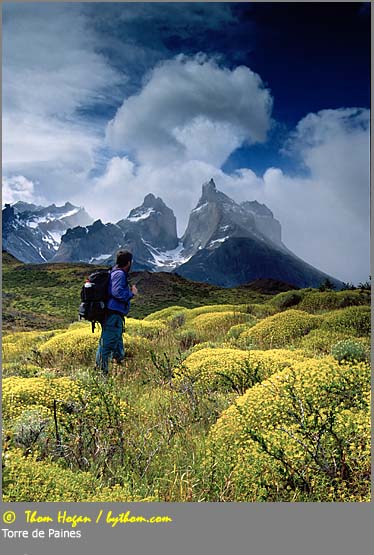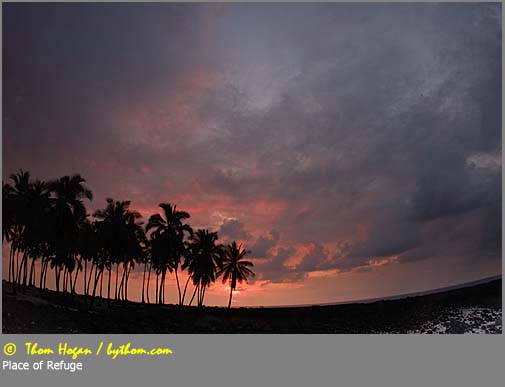The Nature, Wildlife and Pet Photography Forum
Artist Showcase: Thom Hogan
by James Morrissey
This article is Copyright 2005, James Morrissey, and may
not, in part or in whole, be reproduced in any electronic or printed medium without prior permission from the author. The images in this article are the property of Thom Hogan and have been licensed to James Morrissey and the NWP Photo Forum for the purpose of this interview.
Part III: Thom on the Environment
 JM: I have read several of your articles that were posted on the internet about wildlife and nature conservation. It is obviously an important part of your value system. What do you list as the top dangers to the National and State Parks?
JM: I have read several of your articles that were posted on the internet about wildlife and nature conservation. It is obviously an important part of your value system. What do you list as the top dangers to the National and State Parks? TH: Oh geez, there are so many that come to mind that I might end up talking for hours on this subject. Overall, the issue that comes to the forefront for the National Parks since President Bush took office is that funding has been in jeopardy and privatization is being pushed. While the Bush administration may point to some funding increases, you have to look at where those increases have gone and what's still underfunded. Much of the NP money has gone to or is destined for (needed) infrastructure issues--plumbing in Yellowstone, the Going-to-the-Sun road in Glacier, and so on. Huge backlogs of such maintenance projects exist, with hundreds of millions of dollars of still unfunded items to be accounted for. At the same time, funds for preservation of back-country, natural research, and even rangers on the ground (other than for things like police protection) have disappeared. The net result is that, in some parks, rangers and even part-time summer workers who had the most knowledge of the biological, natural, and historical aspects of our parks no longer work in the parks. They've been replaced by more front country personnel dedicated to visitor comfort (food and lodging provided by private companies) or not replaced at all.
The bills that established the National Park system all speak toward preserving and protecting for future generations. What I see is an effort to make casual front country visitation more painless and more about looking at a few big features. Yosemite is a huge park, but few ever see anything more than Yosemite Valley (front country), and the remainder often see little more than what's along the road to Tuolumne Meadows. That's a shame, since Yosemite contains an amazing variety of terrain and features, most of which are only accessible by trail. I'm not against making the front country more accessible, but I am against making that the priority over all other aspects of park management.
In the state parks, the issue is easier to identify: there's a swing right now towards the federal government cutting funding to the states (and it's not exactly well proportioned as it is, with California only receiving 70 cents on the dollar back from the federal taxes CA citizens pay). The states have the same fiscal crisis the federal government has: health care, retirement, and other social expenses are increasing dramatically at a time when the funding for those is either level or dropping. Some states, such as California, self-imposed funding issues (Prop 13 comes to mind) that further hampered state funding. The result is that many of the states are jettisoning funds to anything that doesn't move, and that includes the state park systems. Short term, we can withstand that kind of neglect, but long term it is very dangerous--we could end up with parks that are nothing more than parking lots with picnic benches and which don't even have toilet facilities because that would cost money to clean and monitor.
So it's a lot about money. If the government won't step up to the plate, we citizens have to. I suppose you could think of it as a self-imposed tax increase. I've put my money where my mouth is. Starting in 2004 I've dedicated 5% of my profits (actually, in the end it turned out to be more) towards projects that affect the areas I photograph in. And you can help me with this. In 2004 I started the Galen Rowell National Trails Fund, a permanent trust fund dedicated to providing money to keep trails and access in wild areas open and maintained. I put in enough money up front to make this a permanent endowment--at present it offers US$500 grant each year. Don't scoff at that--most trail maintenance is volunteer work, so that money buys much more than it at first seems it might. But you can help make that amount increase. The Galen Rowell National Trails Fund is open to others. If fifty of you reading this each contributed US$10, that would replenish the initial trust, and due to interest, make for a larger grant next year. The fund and the grants are monitored and chosen by the American Hiking Society, a non-profit organization dedicated to local and national trails. To contribute, just go to
www.AmericanHiking.org and fill out the required information.
PLEASE MAKE SURE THAT you add a note or comment that your money is to go to the Galen Rowell National Trails Fund--AHS maintains many trust funds, so you'll want to make sure that your money gets to the right place.
I fully intend to continue doing something different each year (i.e., in 2005 I'll fund a new initiative). My hope is that I'm planting lots of little conservation seeds that'll bloom for generations to come.
JM: What ideas do you think a group like NWP (and others here on the net) can do to promote real environmental change?TH: Well, aside from contributing to the fund I just suggested, you just have to get involved with something, anything, at your local level. The Sierra Club has local chapters everywhere. Most state and federal parks have docent or other volunteer programs you can get involved with. Call up the biology department of your local college and find out who's doing natural research and arrange to talk to them; offer to help document their research with your photos. If you live near ANY wildlife refuge, national monument, or other designated lands, just go down to their local office and find out what they need and ask them how you can help them. You'll not only help them, but you'll help yourself. Here's the dirty little secret: almost all of the successful nature and wildlife photographers have close relationships with land managers, researchers, and others involved with our wild lands. That's how they know where to go and when! Indeed, if you develop a good enough relationship with one of these folks, you'll often be invited along on
monitoring or research trips that provide once-in-a-lifetime photography opportunities.
As for NWP, organizations best serve as matchmakers for what I have just talked about. Find 100 researchers who need documentary, monetary, and logistics help and link them up with budding photographers. (This mimics what AHS does with trails, by the way. AHS has funding sources that it tries to link up with those needing funding, amongst other things.)
 JM: Would you like to talk about the American Hiking Society and what your role is with them?
JM: Would you like to talk about the American Hiking Society and what your role is with them?TH: Well, I already have. (Smiles broadly) But there's more there that's worth talking about. AHS has a program called Volunteer Vacations. If you're prepared to work your butt off while having the time of your life in some wonderful photographic locale, there's not a better bargain on the planet. You WILL work. I had to burn all my clothes from my Admiralty Island Volunteer Vacation because they were covered with sap, bug juice, and ripped in so many places I stopped counting. But in between swinging the scythe and ax I managed to also rip off some incredible pictures I wouldn't have gotten otherwise.
JM: Are there any small philanthropic organizations that you know of that do not get much press, but do great work, that you feel should be mentioned?TH: That's a good question. I'm not sure anyone's really compiled a good list, and now you've just put another darned thing on my to-do list. (Laughs) Short of me providing that list, why not make NWP the repository of such a list? If everyone reading this can come up with one or two worthy organizations and you do a basic vetting on them, you'd have something that simply doesn't exist for nature photography right now. NANPA (North American Nature Photography Association) hasn't even managed to do that, to my knowledge. Hint, hint: if you're reading this and not a member of NANPA, you should be. If you mention my name when you join, I'll get NANPA bucks as a reward, but here's what I'll do: I'll donate those NANPA bucks to some
photography student somewhere--that way we'll all benefit.
Thanks again to Thom Hogan for having done this interview with us. As I said earlier, he was the first person to grant us an interview and I will always appreciate that. To learn more about Thom, check out his website, ByThom.com